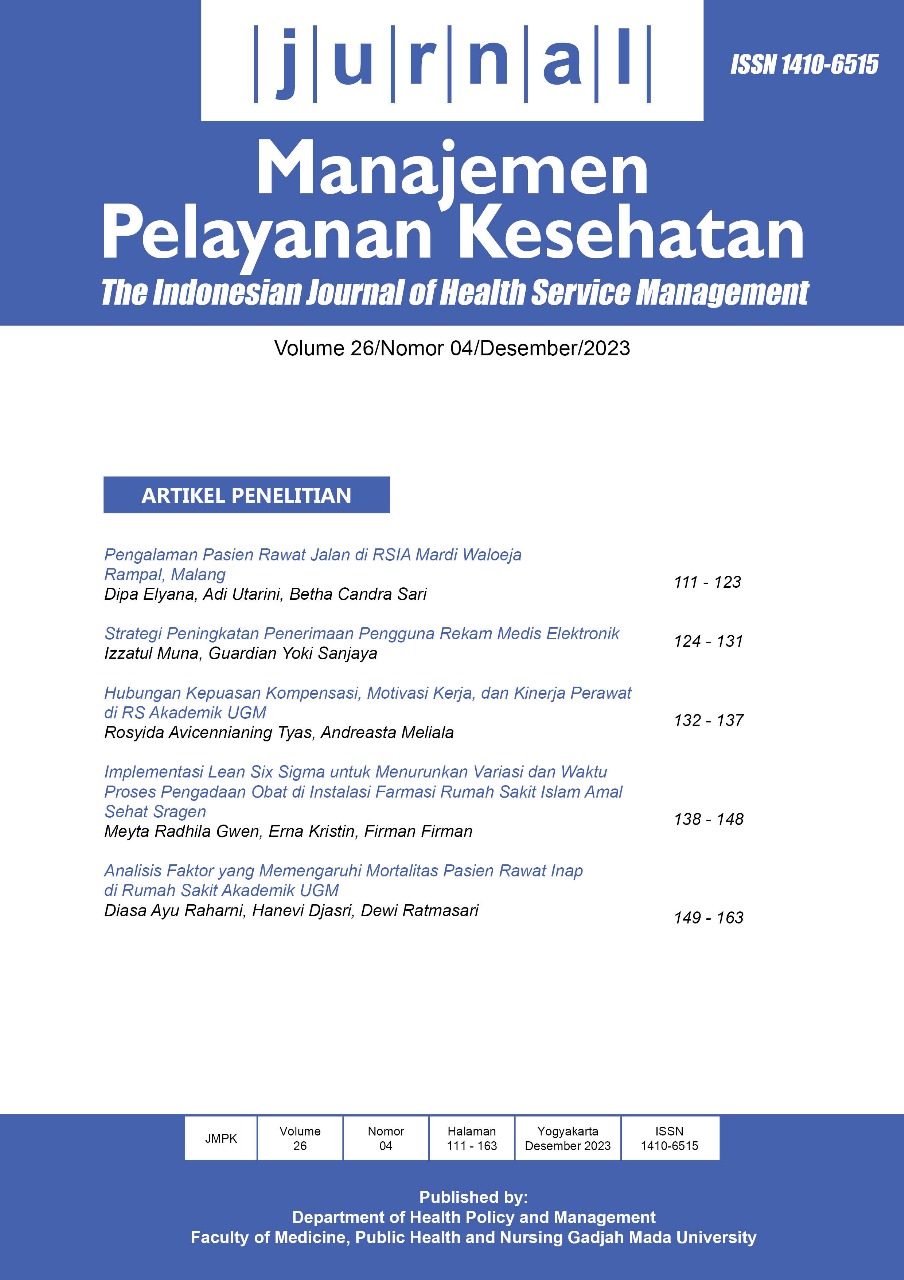STRATEGI PENINGKATAN PENERIMAAN PENGGUNA REKAM MEDIS ELEKTRONIK
Abstract
Background: The benefits of using electronic medical records have encouraged the government and hospitals in Indonesia to continue developing them. Many factors support and hinder the successful implementation of electronic medical records. User acceptance is a key variable in the mandatory use of electronic medical records. The Unified Theory of Acceptance and Use of Technology is the theory used to evaluate EMR and factors that influence user acceptance, namely intention to use RME.
Objective: This study aims to identify the influence of UTAUT indicators on the behavior intention to use outpatient electronic medical records.
Methods : This research used a descriptive case study approach with a location at PKU Muhammadiyah Wonosobo Hospital with a sample of all users of outpatient electronic medical records. The research was conducted with in-depth interviews with 10 informants and distributing questionnaires to 95 respondents who were analyzed using SmartPLS.
Results: Outpatient RME users at PKU Muhammadiyah Wonosobo Hospital accept to use and utilize the system now and in the future due to positive perceptions of performance expectations, effort expectations, and facility conditions. Obstacles are still found that hamper the acceptance of outpatient RME users including RME not yet integrated with all services in the hospital, RME feature dysfunction, interoperability interference, data access is not automatic, availability of inappropriate infrastructure, lack of availability of skilled IT human resources, lack of regulation. Performance expectation has a positive and significant effect on usage intention (t=2.381; p=0.018). Expectation of effort has a positive and significant effect on intention to use (t=2.004; p=0.046). Facility conditions have a positive and significant effect on usage intention (t=2.245; p=0.025). Social influence has an insignificant positive effect on intention to use (t=1.179; p=0.239).
Conclusion : Increasing user acceptance of EMR is done by increasing performance expectations, business expectations, and facility conditions that support implementation. User expectations for the use of RME in the future are system improvements, all user needs accommodated, and interoperability so that the system can be fully integrated.
References
Amatayakul, M. K. (2013). Electronic Health Records A Practical Guide For Profesionals and Organization. (M. K. Amatayakul, Ed.) (5th ed.). Jakarta
Amin, M., Setyonugroho, W., & Hidayah, N. (2021). Implementasi Rekam Medik Elektronik: Sebuah Studi Kualitatif. JATISI (Jurnal Teknik Informatika Dan Sistem Informasi), 8(1), 430–442. https://doi.org/10.35957/jatisi.v8i1.557
Rizky, D., & Tiorentap, A. (2020). Manfaat Penerapan Rekam Medis Elektronik Di Negara Berkembang: Systematic Literature Review. Health Information Management Journal ISSN, 8(2), 2655–9129.
Andriani, R., Kusnanto, H., & Istiono, W. (2017). Analisis Kesuksesan Implementasi Rekam Medis Elektronik Di Rs Universitas Gadjah Mada. Jurnal Sistem Informasi, 13(2), 90. https://doi.org/10.21609/jsi.v13i2.544
Kementerian Kesehatan Republik Indonesia. (2021). Cetak Biru Strategi Transformasi Digital Kesehatan 2024.
Fennelly, O., Cunningham, C., Grogan, L., Cronin, H., O’Shea, C., Roche, M., Lawlor, F., & O’Hare, N. (2020). Successfully implementing a national electronic health record: a rapid umbrella review. In International Journal of Medical Informatics (Vol. 144). Elsevier Ireland Ltd. https://doi.org/10.1016/j.ijmedinf.2020.104281
Venkatesh, V., Morris, M. G., Davis, G. B., & Davis, F. D. (2003). User acceptance of information technology: Toward a unified view. MIS Quarterly: Management Information Systems, 27(3), 425–478. https://doi.org/10.2307/30036540
Koh, C. E., Prybutok, V. R., Ryan, S. D., & Wu, Y. (2010). A model for mandatory use of software technologies: An integrative approach by applying multiple levels of abstraction of informing science. Informing Science: The International Journal of an Emerging Transdiscipline, 13, 177–203. http://www.inform.nu/Articles/Vol13/ISJv13p177-203Koh561.pdf
Silvestre, E. (2018). How Electronic Health Records Strengthen the Health Systems of Low- and Middle-Income Countries : Learning from Eswatini and Mexico. Chapel Hill, NC : MEASURE Evaluation, University of North Carolina.
Muchlis, H., & Sulistiadi, W. (2022). Evaluasi Rekam Medis Elektronik Menggunakan Model Unified Theory Of Acceptance And Use Of Technology. Prepotif: Jurnal Kesehatan Masyarakat, 6(1), 533-540.
Tsai, C. H., Eghdam, A., Davoody, N., Wright, G., Flowerday, S., & Koch, S. (2020). Effects of electronic health record implementation and barriers to adoption and use: A scoping review and qualitative analysis of the content. Life, 10(12), 1–27. https://doi.org/10.3390/life10120327
Kusuma, R. S. (2017). Penggunaan internet oleh dosen berdasar gender dan generasi. Komuniti: Jurnal Komunikasi dan Teknologi Informasi, 8(1), 53-63.
Yusof, M. M., Kuljis, J., Papazafeiropoulou, A., & Stergioulas, L. K. (2008). An evaluation framework for Health Information Systems: human, organization and technology-fit factors (HOT-fit). International Journal of Medical Informatics, 77(6), 386–398. https://doi.org/10.1016/j.ijmedinf.2007.08.011
Faida, E. W., Supriyanto, S., Haksama, S., Markam, H., & Ali, A. (2022). The Acceptance and Use of Electronic Medical Records in Developing Countries within the Unified Theory of Acceptance and Use of Technology Framework. Open Access Macedonian Journal of Medical Sciences, 10(E), 326–336. https://doi.org/10.3889/oamjms.2022.8409
Kaboré, S. S., Ngangue, P., Soubeiga, D., Barro, A., Pilabré, A. H., Bationo, N., Pafadnam, Y., Drabo, K. M., Hien, H., & Savadogo, G. B. L. (2022). Barriers and facilitators for the sustainability of digital health interventions in low and middle-income countries: A systematic review. Frontiers in Digital Health, 4(November), 1–16. https://doi.org/10.3389/fdgth.2022.1014375
Venkatesh, Viswanath, Fred D. Davis. 2000. A Theoritical Extension of the Technology Acceptance Model: Four Longitudinal Field Studies. Management Science, Vol. 46, No. 2, pp. 186-204.
Copyright (c) 2024 Izzatul Muna, Guardian Yoki Sanjaya

This work is licensed under a Creative Commons Attribution-NonCommercial-ShareAlike 4.0 International License.




